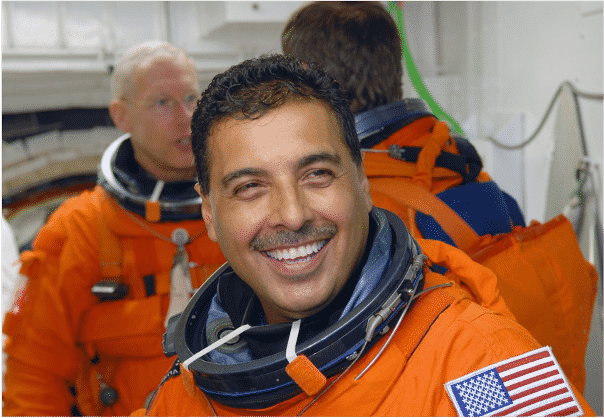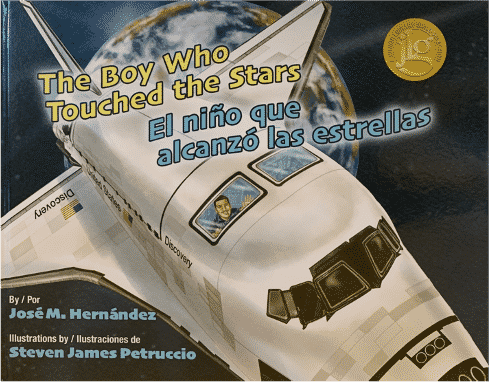This Mexicano Went From Campesino to Astronaut, Now His Daughter and Netflix are Telling His Story
Vanessa Hernández is using social media platforms to tell the world what it’s like to be the daughter of the first Mexican-American astronaut to go from working in the fields to being launched into outer space as an astronaut in hopes of leaving a positive impact and inspire future generations.
“Something that I really admire about my father that I’m trying to practice every day is to have that fearlessness of you should take risks [to achieve] what you want to do,” the Loyola Marymount University graduate tells FIERCE.
On August 28th, 2009, astronaut José Hernández became NASA’s first first-generation Mexican American and the first migrant farmworker astronaut in space aboard the Space Shuttle Discovery on Space Shuttle mission STS-128.

An engineer who co-developed the very first full-field digital mammography imaging system for early detection of breast cancer, hard work, perseverance, and grit were nothing new to him even if he had to create his own path.
His journey to space only came after being rejected from NASA 11 times.
“I always tell Vanessa and the kids that you can’t give up on your dream. I know I wanted to give up after six times of being rejected and my wife was the one that actually convinced me not to, because she said, ‘you’re always going to have that worm of curiosity inside of you wondering what if you didn’t quit? NASA is not telling you don’t apply, you’re just quitting. And I started thinking about it and I said, you know, she’s right,” says the father of five.
Looking to the first Latino astronaut in space, Costa Rican Chang Diaz, Hernández knew this too was possible for him.
“I got excited because I said, well, it’s not just for the white Caucasians anymore. They’re actually letting people of color into the ranks of NASA. Maybe I could come back behind him and pave a way to make it even easier for other people.”
Besides co-developing the first mammography machine, and having both his bachelor’s and master’s degrees, José became a certified scuba driver, obtained his pilot’s license, and learned Russian amongst many other qualities, to ensure he was as qualified for NASA as he could possibly be.
On the 12th time Hernández applied to NASA, he was accepted into the class of astronauts. This had been a dream of his since he was 10 years old when he saw the Apollo 17 mission live on television.

“That’s when the dream was conceived, December of 1972 in Stockton, California in the evening. Picture a 10-year-old kid, holding up a rabbit ear antenna on a big console type TV, vacuum tube technology, watching the black-and-white images, as astronaut Eugene Cernan walked on the moon,” says Hernández.
“It was those images that basically allowed me to conceive the dream of saying, ‘Hey, I want to be just like this guy.’ And so that’s from day one as a 10-year-old boy in the fifth grade, I knew I wanted to be an astronaut,” he adds.
Born to two Mexican migrant farmworkers from Michoacán, Jose Hernández and his family moved constantly to follow the harvest in order to survive financially. Due to the frequent change of schools, Hernández didn’t learn English until he was 12 years old.
“While a lot of my friends loved summer vacation, we hated it because we knew it was the peak of harvest there,” recalls Hernández.

“We knew we were going to be spending seven days a week, with my siblings, with my mom, and with my dad in the fields working,” says Hernández.
While adapting to the English language proved to be a struggle in an English-speaking American school, in the end, this language barrier may have lead him to achieve his dream.
“I think that allowed me to focus on math because two plus three is five in any language. That’s why I think I went into engineering because of the fact that math and science were more universal than the other subjects in class,” says Hernández.
Vanessa’s childhood, while very different from her father’s as a second-generation Mexican-American, still possessed the same grit as her dad.

Growing up in predominantly non-Latino neighborhoods and schools, Vanessa felt pressured to assimilate more. “I have an older sister who is disabled. She has a learning disability, so it was really difficult for us as a family to learn both languages at the same time. So we had to really make a decision for a family and pick one language which was English,” Vanessa tells FIERCE.
Nevertheless, she took strides or gave it ganas, as she says, to embrace her Mexican identity. She communicated with her grandparents in Spanish and lived in Mexico for a semester.
“I understand Spanish, I love speaking it with my family. So, it’s just a little bit of a different upbringing where I’m learning Spanish, and my dad was learning English. I want to speak Spanish and connect to my culture and heritage more.”
“When you get into second and third generations, everyone has different experiences but that doesn’t make you any less Mexican, that doesn’t make you any less Latino,” says Vanessa.

Vanessa’s close relationship with her dad has enabled her to explore her own purpose in life even though it has not been easy, she says.
“Unlike my dad, I didn’t know at 10 years old, what I wanted to do a hundred percent. So I spent a lot of my youth and young adulthood figuring it out and, you know, went to school, graduated and still was figuring it out.”
Since graduating Loyola Marymount University in 2019, Vanessa has taken to TikTok — a place she oftentimes tells pieces of her dad’s story. And her TikTok audience of 64k loves it.
“I graduated in 2019. It took me a full year to really take a step back and be like, ‘I’ve heard my dad’s stories so much in my own life that I haven’t actually really been listening.’ I think when I started to really think about it is when we started making TikToks together and seeing how much it really connected with other people and how much he was an inspiration to others. And I just thought to myself, he can inspire all of these people and get such a positive response to his story. If he can do it, I can do it.”
José and Vanessa are very different yet one of the same. “He’s very STEM-oriented. I’m very creative,” says Vanessa. José tells FIERCE that Vanessa’s entrepreneurial spirit really helps bring to life her messages of body positivity and Latina pride. “I’m looking at learning a lot from her from that perspective,” adds José. “As a matter of fact, I’m already tapping her for some advice on stuff that I want to do.”
In the same way, José inspires his daughter.
“I can’t be selfish with having him as a dad and keep his story to myself. I almost see it as like I have so many platforms that I can use to share his story, to inspire others too, no matter what it is, whatever they want to pursue, that they can do it regardless of what background they come from,” says Vanessa.
The risks Hernández took that transported him from farm fields to outer space will be depicted in an upcoming Netflix film based on his inspirational life journey and he and his daughter Vanessa will be very involved in the process.


A man born in Stockton, California to two Spanish-speaking migrant farm workers from Michoacán, the movie is based on Hernández’s autobiographies Reaching for the Stars and From Farmworker To Astronaut. These books are also written in his mother tongue, Spanish, titled El cosechador de estrellas and De campesino a astronauta respectively.
The Netflix original titled A Million Miles Away is set to be directed by Mexicana director Alejandra Abella Márquez.
Márquez directed the critically-acclaimed Niñas Bien and has helped lead Mexico’s Ya Es Hora movement (similar to the #MeToo movement) condemning gender violence and empowering stories told by women.
The film is set to film in summer 2021 on José’s story, a man who achieved many firsts.
José is an inspiration to not just his generation but his daughter’s as well, and Vanessa’s personal life may also resonate with her own generation.
“I feel really called to also share those experiences with people because I see people relating to me as well, you know, not knowing what they want to do, being a young adult in today’s age, where you’re supposed to have everything figured out, but no one really does. And that’s okay. And if you’re single, that’s okay. If you want to take a break from school and pursue a passion project, start a business, all of these things. That’s okay.
The biggest lesson that I’ve learned is that anything is possible.
And I feel called to really do my part and share not only my dad’s story, but my story too, and work together and just start all of these different things.”
Besides viral TikToks, now, this father-daughter duo mix both their passions and personalities for future enterprises.
Some of these projects includes an upcoming wine label, Tierra Luna Cellars, that the two will be promoting together — José with his idea, and Vanessa with her social media savviness. In the same way, José hopes he can have his daughter get involved in the social media promotion of the Netflix movie.
Both José and Vanessa hope that this movie will be able to communicate José’s story to many more of those who need to see a Mexican man, son of migrant farmworkers, make it to outer space.


José fuels this passion with other programs he creates. In order to “increase the STEM pipeline of underrepresented groups like African-Americans and Latinos,” as José would say, he created the non-profit Reaching for the Stars Foundation in his home community of Central Valley California to encourage youth “to find passion in Science, Technology, Engineering and Mathematics.”
The non-profit includes a five week STEM academy for 7th-12th graders, summer camp hands-on Exploratorium experiences, and a scholarship fund for graduating high school seniors.
“There’s a power of empowerment when they see someone that looks like them, talks like them, and comes from very similar backgrounds. [The non-profit] shows that other people besides their parents and immediate family believe in them, other people are investing in them. And I think that’s important because now they say, ‘wow, people believe in me,’ and they get pumped up and off they go to college and they do well. That’s what we try to do,” says José.
Now, everything seems to be coming full circle as José reminisces on his experiences in space which will also be featured in the film.

“Once you crawl into the shuttle, you crawl in about three hours before launch. So you’ve got plenty of time to make peace with your maker.” He refers to how the life of an astronaut can be fatally dangerous. A tragic example in history is the Columbia Space Shuttle that blew up during launch in 2003, killing all seven crew members instantly. His daughter Vanessa says, “I think if he went now as an adult, I would beg him not to because it’s, it’s so much more dangerous than people think. I had a classmate whose dad was in the shuttle.”
Nonetheless, José’s time in space was life-changing.
“When the countdown goes to zero, you hear the three engines come to life. You go from zero to 17,500 miles an hour in eight and a half minutes. That’s the best ride Disneyland could ever hope for,” José tells FIERCE.

He adds, “It feels like three people that weigh exactly as much as you do are stepping on your chest,” says José. The space journey was a 14-day mission to finish building the International Space Station. After being rejected from NASA numerous times, and learning Russian, José realized “this was the same space station I read that we were going to build with the Russians there, and I am participating in the second to last mission to finish this construction.”
Vanessa was only 13 when her dad went on the space mission. “We had the best seats in the house. It was just like watching like the biggest shooting star. It took about eight to 10 minutes for it to completely disappear. At that point you have like this like sinking feeling of like, Oh, like my dad’s not on this planet.”
Vanessa recalled her dad Skyping with them in space showing them tricks like spinning in mid-air fetal position or squeezing water out of pouches between life-saver gummies to look like a floating worm he’d try to drink/eat. José says perhaps the best thing about space was the view.
“You look down at the beauty of our earth and then the opposite window, you have the window to the universe and you see how magnificent it is and how perfect it is that you say, you know, this is too perfect for it to be a coincidence,” says José.


José even said he was able to see from space the Paris lights, the mountains across the U.S., the beaches of Yucatan, and his motherland of Michoacán, Mexico. Now, this city will get to see one of their own in a Netflix film.
On the way home, José and the rest of the team were supposed to land in Florida, but due to a bad storm they had to land in California at the California Edwards Air Force Base. He says, “I call it poetic justice because Edwards Air Force Base is about 80 miles from where I used to pick strawberries.”
A Million Miles Away film for Netflix is set to film in summer 2021. In the meantime, you can catch more of José and Vanessa Hernández on Tiktok.




